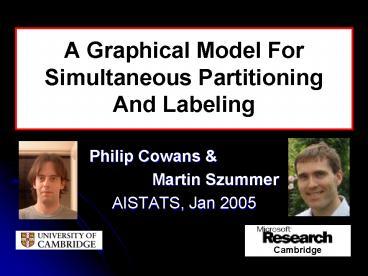A Graphical Model For Simultaneous Partitioning And Labeling - PowerPoint PPT Presentation
Title:
A Graphical Model For Simultaneous Partitioning And Labeling
Description:
A Graphical Model For Simultaneous Partitioning And Labeling. Philip ... Thomas Minka, Yuan Qi and Michel Gagnet for useful discussion and providing software. ... – PowerPoint PPT presentation
Number of Views:68
Avg rating:3.0/5.0
Title: A Graphical Model For Simultaneous Partitioning And Labeling
1
A Graphical Model For Simultaneous Partitioning
And Labeling
- Philip Cowans
- Martin Szummer
- AISTATS, Jan 2005
Cambridge
2
Motivation Interpreting Ink
Hand-drawn diagram
Machine interpretation
3
Graph Construction
Vertices are grouped into parts.
Vertices, V
Each part is assigned a label
G
Edges, E
4
Labeled Partitions
- We assume
- Parts are contiguous.
- The graph is triangulated.
- Were interested in probability distributions
over labeled partitions conditioned on observed
data.
5
Conditional Random Fields
- CRFs (Lafferty et. al.) provide joint labeling of
graph vertices. - Idea define parts to be contiguous regions with
same label. - But
- Large number of labels needed.
- Symmetry problems / bias.
2
1
2
-1
-1
3
3
6
A Better Approach
- Extend the CRF framework to work directly with
labeled partitions. - Complexity is improved dont need to deal with
so many labels. - No symmetry problem were working directly with
the representation in which the problem is posed.
7
Consistency
- Let G and H µ V.
- Y (G) and Y (H) are consistent if and only if
- For any vertex in G Å H, Y (G) and Y (H) agree on
its label. - For any pair of vertices in G Å H, Y (G) and
Y (H) agree on their part membership. - Denoted Y (G) v Y (H).
8
Projection
- Projection maps labeled partitions onto smaller
subgraphs. - If G µ V then, the projection of Y onto G is the
unique labeled partition of G which is
consistent with Y.
9
Notation
10
Potentials
11
The Model
- Unary
- Pairwise
12
The Model
13
Training
- Train by finding MAP weights on example data with
Gaussian prior (BFGS). - We require the value and gradient of the log
posterior
Normalization
Marginalization
14
Prediction
- New data is processed by finding the most
probable labeled partition. - This is the same as normalization with the
summation replaced by a maximization.
15
Inference
- These operations require summation or
maximization over all possible labeled
partitions. - The number of terms grows super-exponentially
with the size of G. - Efficient computation possible using message
passing as distribution factors. - Proof based on Shenoy Shafer (1990).
16
Factorization
- A distribution factors if it can be written as a
product of potentials for cliques on the graph - This is the case for the (un-normalized) model.
- This allows efficient computation using message
passing.
17
Message Passing
8
9
7
1
2
3
4
5
6
18
Message Passing
2,9
1,7,8
1,2,3,4
Upstream
Message summarizes contribution from upstream
to the sum for a given configuration of the
separator.
Junction tree constructed from cliques on
original graph.
2,3,4,5
4,5,6
19
Message Passing
2,9
1,7,8
1,2,3,4
2,3,4,5
x22
4,5,6
20
Message Update Rule
- Update messages (for summation) according to
- Marginals found using
- Z can be found explicitly
21
Complexity
22
Experimental Results
- We tested the algorithm on hand drawn ink
collected using a Tablet PC. - The task is to partition the ink fragments into
perceptual objects, and label them as containers
or connectors. - Training data set was 40 diagrams, from 17
subjects with a total of 2157 fragments. - 3 random splits (20 training and 20 test
examples).
23
Example 1
24
Example 1
25
Example 2
26
Example 2
27
Example 3
28
Example 3
29
Labeling Results
- Labelling error fraction of fragments labeled
incorrectly. - Grouping error fraction of edges locally
incorrect.
30
Conclusions
- We have presented a conditional model definied
over labeled partitions of an undirected graph. - Efficient exact inference is possible in our
model using message passing. - Labeling and grouping simultaneously can improve
labeling performance. - Our model performs well when applied to the task
of parsing hand-drawn ink diagrams.
31
Acknowledgements
- Thanks to
- Thomas Minka, Yuan Qi and Michel Gagnet for
useful discussion and providing software. - Hannah Pepper for collecting our ink database.































